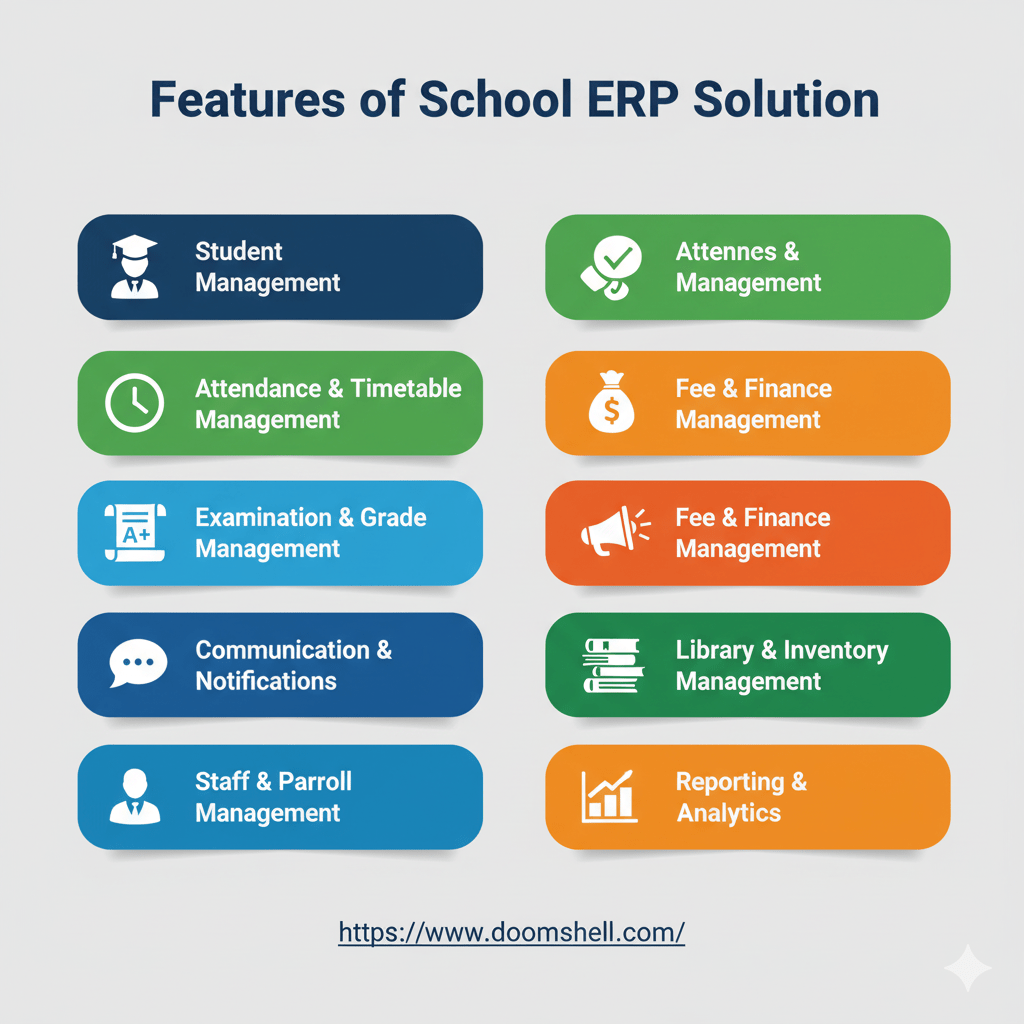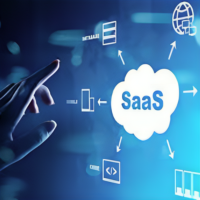Introduction of School EPR Solution
A School ERP Solution is a comprehensive academic framework designed to reduce and automate a school’s administrative, academic, and management systems. It centralizes any information that involves students, teachers, staff, finances, examinations, attendance, and communication information, so everyone can access the data, and work efficiently. A School ERP will reduce manual tasks and allow for real-time data management and planning and allows better resource planning to create an effortless end-user experience for administrators, teachers, students, and parents.
Key Takeaway
- A School ERP solution combines various academic and administrative functions into one centralized location, boosting efficiency, communication, and resource management.
- Core modules might include: Student Management, Teacher and Staff Management, Parent Portal, Finance & Fee Management, Exams & Assessment, Library & Transport Management, and Notifications/Alerts.
- Choosing the right technology stack (e.g., React, Angular, Node.js, Python, MySQL, etc.) can make sure that the application scales well, is secure, and the modules can be easily integrated on web and mobile devices.
- The UI/UX design is an essential part of providing a user-friendly experience for administrators, teachers, students, and parents.
- The application can be monetized through licensing fees, subscription model, premium modules and setup and maintenance fees.
Market Analysis of Global School ERP Solution
- The global School ERP market was valued to be around USD 16.42 billion in 2023 and is expected to grow to USD 61.23 billion by 2030 at a CAGR of 21.98% as digital use in education continues to become ubiquitous.
- North America will still represent the largest share of the market due to the number of established ERP vendors, and the Asia-Pacific area will probably have the most significant growth rate, as countries such as India and China have fast moving digitalization processes.
- Schools want to transition to cloud-based ERPs as they are looking for flexibility, scalability, and affordability after moving off of on-premise legacy systems.
- AI, analytics, and mobile technology create complimentary and mind-expanding decision making capability, automates administrative tasks, and allow for more engaging experiences for both students and teachers.
- Government programs – such as India’s Samarth portal – are also continuing the digital management of schools, and there is much participation and interest in customizable and modular ERP in order to satisfy institutional needs.

Steps to Develop a School ERP Solution
1. Requirements Gathering: Gather information on what the school is seeking from administrators, teachers, students, and parents. Understand any modules that will need to be part of the admissions, attendance, timetable, exams, finance, communications, etc.
2. System Design & Planning: Once you have developed a vision of the ERPS system; determine how the database architecture will look, how the user interfaces will look, and how the various modules will interact and connect. Determine the technology stack, whether the ERPS will be hosted in the cloud, local, or hybrid; as well, develop the security policies.
3. Development & Coding:Develop the ERP system for all the modules based on the design you developed out of stage and add functions such as fee tracking, the student module, notifications, grade reporting, etc. Keep in mind scalability and usability.
4. Testing & Quality Assurance: Test the ERP for functionality, performance, security, and compatibility. Record and fix bugs, validate workflow, and most importantly, ensure that all the modules and components work with each other without conflicts.
5. Integration & Training: Integrate the ERPS in the school context and train staff, teachers, and students throughout the use of the new ERPS into the framework of the school. Provide ongoing support and updates for development, as improvement is never a completed process.

Features of School EPR Solution
1. Student Management: Keep detailed records on every student, including academics, attendance, behavior, and extracurricular activities, all in one place.
2. Attendance & Timetable Management: Reduce the issues of attendance keeping and timetable arrangements for students and staff by automating these processes as much as possible to effect accurate outcomes, ultimately minimizing human error.
3. Examination & Grade Management: Effortlessly manage examinations, examination schedules, grade entry, report cards, and records of performance, leaving educators with quick access to academic history.
4. Fee & Finance Management: Manage the fee collection process, dissemination of invoices, student payment records, and any reports you want regarding the department/school’s finances. Sending reminders automatically for late fees can improve your collection practices and make your position financially secure.
5. Communication & Notifications: Allow instant communication between school, teachers, students, and parents via messaging, email, mobile notifications, and reporting. Have the ability to share updates, events, and emergencies quickly.
6. Library & Inventory Management: Keep accurate records of all library items, track loans and returns, and manage the school’s inventory of supplies and equipment.
7. Staff & Payroll Management: Keep employee records, attendance, leave, payroll, evaluations, all in one platform.
8. Reporting & Analytics: Report and provide analytics on a teacher’s performance, weekly, monthly, or yearly, and on academic history and attendance (school level, class level, or even individual report), finances, and general school operation all in real time.

Conclusion
In summary, a School ERP Solution is an all-in-one software that automates the administrative, academic, and management tasks of educational institutions. School ERP increases efficiency, reduces the potential for human error, and provides more accurate reporting and better decision-making by automating processes, providing a centralized, single source of data, and improving communication. In short, implementing a school ERP simplifies day-to-day tasks while providing a more organized system for students, teachers, and administrators. If you want to develop school ERP solutions, contact a mobile app development company in India.
Important FAQs
1. What is a School ERP Solution?
A School ERP Solution is a holistic software application that helps organize and oversee the administrative, academic, and operational functions for a school.
2. Who can a School ERP be used by?
School ERP’s can be used by school administrators, teachers, students, and parents as a means of managing academic subjects, attendance, communication, fees etc.
3. What are the top benefits of using a School ERP?
A School ERP can increase efficiency, reduce manual work and duplicated processes, centralize data, streamline communications and enable real-time reporting for decision making.
4. Is a School ERP accessible from anywhere?
Yes, most current School ERP systems are cloud-based, which users can securely access from anywhere as a web-based or mobile application.
5. How configurable is a School ERP?
School ERP’s can be configured to a high degree, allowing schools to add/change modules(to), workflows and reports to their specific needs.
Also Read













































